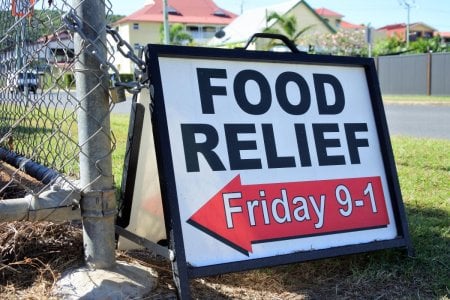Rising cost of living sparks alarming surge in food insecurity across Australia
- Replies 12
As the cost of living continues to rise, many Australians are grappling with financial pressures that significantly impact their daily lives.
Recent findings reveal a troubling trend: a growing number of individuals are struggling to make ends meet, leading to increased stress and uncertainty.
This stark reality serves as a wake-up call, highlighting the urgent need for solutions and support to help those affected navigate these challenging times.
As communities rally to address these issues, the focus remains on finding ways to ease the burden and foster resilience among those facing economic hardship.
A recent report by Foodbank, a leading charity dedicated to fighting hunger, has shed light on the alarming extent of food insecurity in the nation, revealing a situation that is nothing short of a national crisis.
The Foodbank Hunger Report 2024 has unveiled that an estimated 870,000 low-income households in Australia, earning less than $30,000 annually, are grappling with food insecurity.
This figure represents a staggering 48 per cent of such households, marking the highest rate since the onset of the cost-of-living crisis and a five per cent increase since 2022.

The report's findings are a sobering reminder of the warning signs that experts have been pointing to for some time now.
It paints a picture of a society where the most vulnerable are frequently skipping meals, with some enduring days without food.
The statistics are heart-wrenching: nearly 60 per cent of these households are regularly missing meals or going entire days without eating, and single-parent households are the hardest hit, with two-thirds reporting regular food shortages.
The sense of insecurity extends beyond just the immediate lack of food. Around 70 per cent of respondents admitted to feeling uncertain about where their next meal would come from.
This anxiety is felt more acutely in regional areas, where residents are often more isolated from support services and face additional challenges, such as higher transport costs.
Brianna Casey, CEO of Foodbank Australia, has expressed deep concern over the findings, stating that families are ‘reaching their limits’.
‘It is staggering to think that food insecurity was experienced in almost 1 in 3 (32 per cent) Australian households at some point in the last 12 months,’ she stated.
‘People in these households reduced the quality, variety or desirability of their food; skipped meals or at worst, went entire days at a time without eating.’
‘We warned at the beginning of the cost-of-living crisis that low-income households were always going to suffer first, worst and for the longest, and these findings confirm this. We are seeing families that were just getting by, now reaching their limits and making unimaginable choices,’ Ms Casey added.
It comes as no surprise that Casey noted families are having to ‘cut back on the most basic of essentials—nutritious food’ due to the rising costs of housing and essential goods, especially food and utilities.
‘While wages fail to keep pace—all of which are entirely outside of the control of most Australian households,’ Ms Casey said.
The report also indicates that over half of food-insecure households are now seeking food relief more frequently than a year ago.
However, the number of households receiving help from friends and family has decreased, from 32 per cent in 2023 to 25 per cent in 2024.
This decline is a stark indicator of the widespread nature of the crisis, as the support network for many is shrinking.
‘This is an alarming statistic that demonstrates just how desperate the situation has become for those who were once a lifeline, suddenly finding themselves living pay to pay, watching every dollar and sadly, no longer in a position to extend help to loved ones and friends,’ Ms Casey pointed out.
‘We know it’s going to take months, if not years, for many families to bounce back.’
‘We will continue to wrap our arms around our communities for as long as it takes, doing our bit to help nutritious, culturally appropriate food get to as many struggling households as possible,’ she added.
Foodbank encourages anyone in need to find their nearest food relief service by visiting foodbank.org.au.
As rising costs of living continue to strain Australian families, many are left grappling with difficult choices regarding their finances and daily needs.
This challenging environment has pushed some individuals to seek unconventional methods just to make ends meet.
The reality is becoming increasingly stark for vulnerable Australians, prompting discussions about the lengths people will go to in order to survive week by week.
 We invite you to share your thoughts and experiences on this issue. Have you or someone you know been affected by food insecurity? What do you think can be done to help those in hardship? Your stories and ideas are valuable, and by sharing them, we can work towards a solution together.
We invite you to share your thoughts and experiences on this issue. Have you or someone you know been affected by food insecurity? What do you think can be done to help those in hardship? Your stories and ideas are valuable, and by sharing them, we can work towards a solution together.
Recent findings reveal a troubling trend: a growing number of individuals are struggling to make ends meet, leading to increased stress and uncertainty.
This stark reality serves as a wake-up call, highlighting the urgent need for solutions and support to help those affected navigate these challenging times.
As communities rally to address these issues, the focus remains on finding ways to ease the burden and foster resilience among those facing economic hardship.
A recent report by Foodbank, a leading charity dedicated to fighting hunger, has shed light on the alarming extent of food insecurity in the nation, revealing a situation that is nothing short of a national crisis.
The Foodbank Hunger Report 2024 has unveiled that an estimated 870,000 low-income households in Australia, earning less than $30,000 annually, are grappling with food insecurity.
This figure represents a staggering 48 per cent of such households, marking the highest rate since the onset of the cost-of-living crisis and a five per cent increase since 2022.

Foodbank’s latest report reveals that many low-income Australian households are facing food insecurity, with some skipping meals or going days without food. Credit: Shutterstock
The report's findings are a sobering reminder of the warning signs that experts have been pointing to for some time now.
It paints a picture of a society where the most vulnerable are frequently skipping meals, with some enduring days without food.
The statistics are heart-wrenching: nearly 60 per cent of these households are regularly missing meals or going entire days without eating, and single-parent households are the hardest hit, with two-thirds reporting regular food shortages.
The sense of insecurity extends beyond just the immediate lack of food. Around 70 per cent of respondents admitted to feeling uncertain about where their next meal would come from.
This anxiety is felt more acutely in regional areas, where residents are often more isolated from support services and face additional challenges, such as higher transport costs.
Brianna Casey, CEO of Foodbank Australia, has expressed deep concern over the findings, stating that families are ‘reaching their limits’.
‘It is staggering to think that food insecurity was experienced in almost 1 in 3 (32 per cent) Australian households at some point in the last 12 months,’ she stated.
‘People in these households reduced the quality, variety or desirability of their food; skipped meals or at worst, went entire days at a time without eating.’
‘We warned at the beginning of the cost-of-living crisis that low-income households were always going to suffer first, worst and for the longest, and these findings confirm this. We are seeing families that were just getting by, now reaching their limits and making unimaginable choices,’ Ms Casey added.
It comes as no surprise that Casey noted families are having to ‘cut back on the most basic of essentials—nutritious food’ due to the rising costs of housing and essential goods, especially food and utilities.
‘While wages fail to keep pace—all of which are entirely outside of the control of most Australian households,’ Ms Casey said.
The report also indicates that over half of food-insecure households are now seeking food relief more frequently than a year ago.
However, the number of households receiving help from friends and family has decreased, from 32 per cent in 2023 to 25 per cent in 2024.
This decline is a stark indicator of the widespread nature of the crisis, as the support network for many is shrinking.
‘This is an alarming statistic that demonstrates just how desperate the situation has become for those who were once a lifeline, suddenly finding themselves living pay to pay, watching every dollar and sadly, no longer in a position to extend help to loved ones and friends,’ Ms Casey pointed out.
‘We know it’s going to take months, if not years, for many families to bounce back.’
‘We will continue to wrap our arms around our communities for as long as it takes, doing our bit to help nutritious, culturally appropriate food get to as many struggling households as possible,’ she added.
Foodbank encourages anyone in need to find their nearest food relief service by visiting foodbank.org.au.
As rising costs of living continue to strain Australian families, many are left grappling with difficult choices regarding their finances and daily needs.
This challenging environment has pushed some individuals to seek unconventional methods just to make ends meet.
The reality is becoming increasingly stark for vulnerable Australians, prompting discussions about the lengths people will go to in order to survive week by week.
Key Takeaways
- A ‘alarming’ new report by Foodbank highlights that a high number of low-income Australian households are experiencing food insecurity, with some skipping meals or going days without food.
- Approximately 870,000 low-income households—earning less than $30,000 a year—are affected by the cost-of-living crisis, marking the highest rate of food insecurity since the crisis began.
- Families, particularly those with a single parent, are suffering extreme hardship, with two-thirds of such households going without meals regularly and, overall, a majority feeling insecure about their next meal.
- Foodbank CEO Brianna Casey warned that the situation for these families is desperate and recovery could take months or years, urging those in need to seek assistance and locate food relief outlets through Foodbank’s website.








